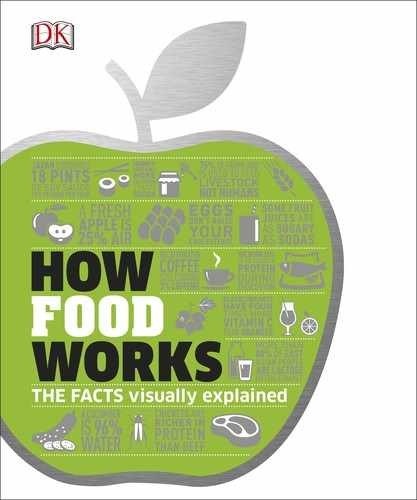
FOOD FUNDAMENTALS
Fibre
Fiber
Fiber is the part of food that is not broken
down by the body, and helps keep your
digestive system functioning properly. It
is found in varying amounts in plant foods.
Types of fiber
Fiber is traditionally characterized into two types. Soluble fiber dissolves in
water, making a thick gel. It is found in foods such as fruit, root vegetables,
and lentils, and prevents constipation by softening stools. Insoluble fiber is
found in foods like cereals, nuts, and seeds. It keeps bowels healthy by
increasing the weight of stools. However, studies have shown that there
is crossover between the two categories and that solubility doesn't always
predict how a type of fiber will behave in the body.
Skin of your greens
In many plants, the most fiber-rich part
is the skin. Apple skins, for example, are
a great source of the insoluble fiber
cellulose. This type of fiber provides
structure to the apple's cell walls.
Fiber strands
Fiber is a carbohydrate comprised of
long chains of sugar molecules. However,
unlike other carbohydrates, they resist
digestion in the stomach. This means they
reach the large intestine intact.
Holding it together
The long strands of cellulose in
apples bond together to form a
rigid framework, which provides
support for the cells.
BROWN BREAD
18
1
⁄2oz (514g)
APPLE
WHEAT CEREAL
6
3
⁄4oz (186g)
DRIED FIGS
9
1
⁄2oz (260g)
CHICKPEAS
15oz (15oz)
5
⁄8oz (18g)
of fiber
KEY
Amount required to
reach
5
⁄8oz (18g) of fiber
Many of us don’t get enough fiber in our diets.
Whole grains are the most common source, but
refined grains have the fiber-rich outer layer removed,
so don’t provide much. The UK recommends
5
⁄8oz
(18g) a day—although recommendations vary.
GETTING ENOUGH FIBER
A
P
P
L
E
C
E
L
L
S
C
E
L
L
U
L
O
S
E
S
T
R
A
N
D
S
C
E
L
L
U
L
O
S
E
S
T
R
A
N
D
Sugar molecule
Cellulose
strands provide
structure to
cell walls
Plant cell
Chain
F
I
B
E
R
S
T
R
A
N
D
S
US_024-025_Fibre.indd 24 18/01/2017 09:41
24
FOOD FUNDAMENTALS
Fibre
25
Fiber and health
Eating plenty of fiber (see pp.198–99)
reduces the risk of heart disease,
certain cancers, obesity, and type 2
diabetes. A high-fiber diet counters
the increased risk of colon cancer
caused by eating processed meat
(see p.219).
Protection
Weak acids produced by
fermentation make the colon
less hospitable to bad bacteria,
lowering the risk of stomach bugs.
Healthy colon
More beneficial bacteria in the
colon increases the mass of
stools, diluting toxins and
keeping the bowel healthy.
Vitamin production
Certain strains of bacteria produce
vitamins, some of which we can
absorb and use. We get some
of our Vitamin K this way.
Improving immunity
Some types of bacteria in your
gut improve your immune system
by producing inflammation-
reducing compounds.
Unexpected benefit
Fiber, particularly the soluble kind, binds to
bile (a bitter liquid that breaks fats down
to tiny droplets), causing it to be excreted. To
replace the bile, the liver must pull cholesterol
out of the bloodstream, which may explain
how fiber lowers the risk of heart disease.
FATTY
ACIDS
FATTY
ACIDS
BLOOD VESSEL
SMALL
INTESTINE
BILE DUCT
L
I
V
E
R
Cholesterol
Cholesterol pulled
into the liver in order
to produce bile
Fiber
Fiber and bile
excreted
Feeding your intestines bacteria
Fiber is an important source of food for your gut
flora (microbes including bacteria and fungi that
live in your intestines) which ferment it into
fatty acids they can feed on. Keeping these
bacteria healthy is vital—they produce
enzymes to help digest other foods and
influence your health in ways that
we are only just beginning
to understand.
VITAMIN K
C
O
M
P
L
E
X
F
I
B
E
R
F
E
R
M
E
N
T
I
N
G
I
N
C
O
L
O
N
US_024-025_Fibre.indd 25 03/02/2017 10:20

24
FOOD FUNDAMENTALS
Fibre
25
Fiber and health
Eating plenty of fiber (see pp.198–99)
reduces the risk of heart disease,
certain cancers, obesity, and type 2
diabetes. A high-fiber diet counters
the increased risk of colon cancer
caused by eating processed meat
(see p.219).
Protection
Weak acids produced by
fermentation make the colon
less hospitable to bad bacteria,
lowering the risk of stomach bugs.
Healthy colon
More beneficial bacteria in the
colon increases the mass of
stools, diluting toxins and
keeping the bowel healthy.
Vitamin production
Certain strains of bacteria produce
vitamins, some of which we can
absorb and use. We get some
of our Vitamin K this way.
Improving immunity
Some types of bacteria in your
gut improve your immune system
by producing inflammation-
reducing compounds.
Unexpected benefit
Fiber, particularly the soluble kind, binds to
bile (a bitter liquid that breaks fats down
to tiny droplets), causing it to be excreted. To
replace the bile, the liver must pull cholesterol
out of the bloodstream, which may explain
how fiber lowers the risk of heart disease.
FATTY
ACIDS
FATTY
ACIDS
BLOOD VESSEL
SMALL
INTESTINE
BILE DUCT
L
I
V
E
R
Cholesterol
Cholesterol pulled
into the liver in order
to produce bile
Fiber
Fiber and bile
excreted
Feeding your intestines bacteria
Fiber is an important source of food for your gut
flora (microbes including bacteria and fungi that
live in your intestines) which ferment it into
fatty acids they can feed on. Keeping these
bacteria healthy is vital—they produce
enzymes to help digest other foods and
influence your health in ways that
we are only just beginning
to understand.
VITAMIN K
C
O
M
P
L
E
X
F
I
B
E
R
F
E
R
M
E
N
T
I
N
G
I
N
C
O
L
O
N
US_024-025_Fibre.indd 25 03/02/2017 10:20
..................Content has been hidden....................
You can't read the all page of ebook, please click here login for view all page.
